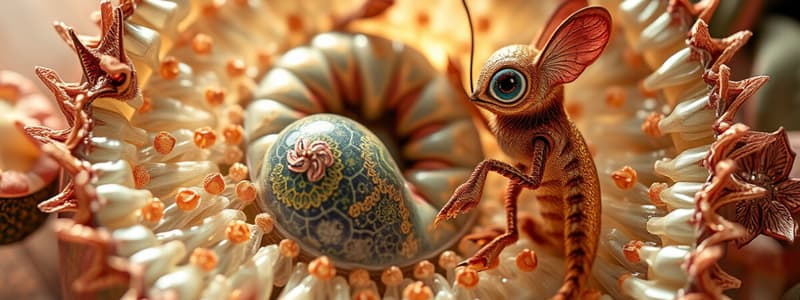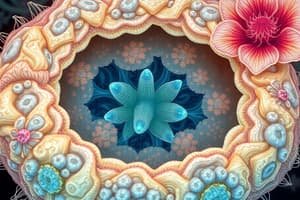Podcast
Questions and Answers
Which of these structures are found in both plant and animal cells? (Select all that apply)
Which of these structures are found in both plant and animal cells? (Select all that apply)
- Nucleus (correct)
- Cell wall
- Cell membrane (correct)
- Chloroplasts
What is a major difference between plant and animal cells concerning support structures?
What is a major difference between plant and animal cells concerning support structures?
Plant cells have a cell wall that provides support, while animal cells do not.
What organelle is necessary for photosynthesis in plant cells?
What organelle is necessary for photosynthesis in plant cells?
Chloroplasts
How do the shapes of plant and animal cells typically differ?
How do the shapes of plant and animal cells typically differ?
In terms of energy storage, what do plant cells use differently than animal cells?
In terms of energy storage, what do plant cells use differently than animal cells?
What is the difference in vacuole structure between plant and animal cells?
What is the difference in vacuole structure between plant and animal cells?
Which organelle do plant cells lack that is present in animal cells?
Which organelle do plant cells lack that is present in animal cells?
Flashcards are hidden until you start studying
Study Notes
Cell Structure Similarities
- Both plant and animal cells possess a cell membrane, which acts as a barrier controlling entry and exit of substances.
- Cytoplasm is present in both cell types, providing a medium for cellular processes.
- The nucleus, responsible for genetic information and regulation, is found in both plant and animal cells.
- Ribosomes, essential for protein synthesis, are present in both types of cells.
- Mitochondria, known as the powerhouse of the cell, produce energy for both plant and animal cells.
- Vacuoles, which store materials, are found in both types of cells but differ in size.
- Both cell types contain endoplasmic reticulum and Golgi bodies, which are involved in manufacturing and transporting cellular materials.
Distinctive Features of Plant and Animal Cells
- Plant cells have a rigid cell wall that provides structural support and protection, whereas animal cells lack a cell wall, allowing for a more varied shape.
- Chloroplasts in plant cells facilitate photosynthesis, enabling them to convert light energy into chemical energy; animal cells do not have chloroplasts.
- Plant cells tend to have a rectangular shape, while animal cells are generally more rounded in appearance.
- Energy storage differs: plant cells utilize chloroplasts to store energy in the form of sugar, while animal cells use mitochondria to release energy from consumed food.
- Plant cells typically possess one large central vacuole for storage and maintaining turgor pressure, while animal cells contain several smaller vacuoles.
- Lysosomes, responsible for digestion and waste disposal, are present in animal cells but are absent in plant cells.
Studying That Suits You
Use AI to generate personalized quizzes and flashcards to suit your learning preferences.



